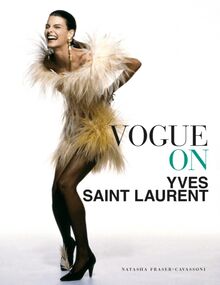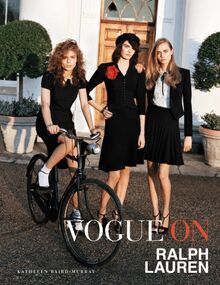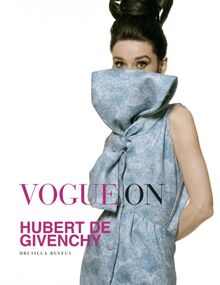-
 Univers
Univers
-
 Ebooks
Ebooks
-
 Livres audio
Livres audio
-
 Presse
Presse
-
 Podcasts
Podcasts
-
 BD
BD
-
 Documents
Documents
-
- Cours
- Révisions
- Ressources pédagogiques
- Sciences de l’éducation
- Manuels scolaires
- Langues
- Travaux de classe
- Annales de BEP
- Etudes supérieures
- Maternelle et primaire
- Fiches de lecture
- Orientation scolaire
- Méthodologie
- Corrigés de devoir
- Annales d’examens et concours
- Annales du bac
- Annales du brevet
- Rapports de stage
La lecture à portée de main
Vogue on Yves Saint Laurent , livre ebook
159
pages
English
Ebooks
2015
Écrit par
Fraser-Cavassoni Natasha
Publié par
ABRAMS BOOKS
Vous pourrez modifier la taille du texte de cet ouvrage
Obtenez un accès à la bibliothèque pour le consulter en ligne En savoir plus
Découvre YouScribe en t'inscrivant gratuitement
Découvre YouScribe en t'inscrivant gratuitement
159
pages
English
Ebook
2015
Vous pourrez modifier la taille du texte de cet ouvrage
Obtenez un accès à la bibliothèque pour le consulter en ligne En savoir plus
Publié par
Date de parution
06 octobre 2015
Nombre de lectures
9
EAN13
9781613128220
Langue
English
Poids de l'ouvrage
3 Mo
Publié par
Date de parution
06 octobre 2015
Nombre de lectures
9
EAN13
9781613128220
Langue
English
Poids de l'ouvrage
3 Mo
Model Carrie Nygren in Rive Gauche s black double-breasted jacket and mid-calf skirt with long-sleeved white blouse; styled by Grace Coddington, photographed by Guy Bourdin, 1975 .
Linda Evangelista wears an ostrich-feathered couture slip dress inspired by Saint Laurent s favourite dancer, Zizi Jeanmaire. Photograph by Patrick Demarchelier, 1987 .
At home in Marrakech, Yves Saint Laurent models his new ready-to-wear line, Rive Gauche Pour Homme. Photograph by Patrick Lichfield, 1969 .
DIOR S DAUPHIN
FASHION S NEW GENIUS
A STYLE REVOLUTION
THE HOUSE THAT YVES AND PIERRE BUILT
A GIANT OF COUTURE
Index of Searchable Terms
References
Picture credits
Acknowledgments
CHRISTIAN DIOR TAUGHT ME THE ESSENTIAL NOBILITY OF A COUTURIER S CRAFT.
YVES SAINT LAURENT
DIOR S DAUPHIN
A
I n fashion history, Yves Saint Laurent remains the most influential designer of the latter half of the twentieth century. Not only did he modernize women s closets-most importantly introducing pants as essentials-but his extraordinary eye and technique allowed every shape and size to wear his clothes. My job is to work for women, he said. Not only mannequins, beautiful women, or rich women. But all women. True, he dressed the swans, as Truman Capote called the rarefied group of glamorous socialites such as Marella Agnelli and Nan Kempner, and the stars, such as Lauren Bacall and Catherine Deneuve, but he also gave tremendous happiness to his unknown clients across the world. Whatever the occasion, there was always a sense of being able to count on Yves. It was small wonder that British Vogue often called him The Saint because in his 40-year career women felt protected and almost blessed wearing his designs.
Although the Paris-based couturier wished that he had invented denim jeans-describing them as the most spectacular, the most practical, the most relaxed, and nonchalant, to Vogue s Gerry Dryansky-he was behind such well-cut staples as the pea coat, the safari jacket, the trench coat, the pant suit, Le Smoking (the female tuxedo), and the introduction of black tights as the chic alternative to pale hosiery. Following in the footsteps of Coco Chanel, Saint Laurent was inspired by black, yet he was a superb colorist who with his bold choice of fabric knew how to brighten an outfit and flatter the complexion.
A s a demonstration of Vogue s attention to promising fashion talent, Saint Laurent had strong links with the magazine from the very start of his career and throughout. It was via Vogue s Michel de Brunhoff that he met Christian Dior, his first and only boss. It was through the enthusiasm of Vogue s Diana Vreeland that the American public became instantly sold on Rive Gauche, Saint Laurent s ready-to-wear line. Meanwhile, Helmut Newton s iconic Smoking portrait taken in 1975 and other memorable images by the likes of Richard Avedon, David Bailey, Guy Bourdin, and Irving Penn were first viewed within the pages of Vogue .
Helmut Newton said Saint Laurent inspired his best fashion photos. His mythic portrait of Vibeke Knudsen wearing Le Smoking on the rue Abriot appeared in Vogue Paris in 1975. The pairing of tailored pant suit and soft blouse typified Saint Laurent s masculine-feminine ambiguity .
Naomi Campbell, a frequent Saint Laurent model, photographed by Patrick Demarchelier in 1987 as a haute-couture-clad showgirl-a favorite nighttime look of the couturier s .
Rive Gauche shirt, sunglasses, and jewelry, are exotically displayed on Marie Helvin, another Saint Laurent favorite, photographed by David Bailey in 1975 .
A GOOD MODEL CAN ADVANCE FASHION BY TEN YEARS.
YVES SAINT LAURENT
Carla Bruni photographed by Dewey Nicks in 1994, wearing Saint Laurent s short couture silk faille evening dress, highlighted with jewelry designed by Loulou de la Falaise .
Lucienne Saint Laurent, photographed for British Vogue by Willy Rizzo in 1960 with the irrepressibly pleased expression of someone whose son has just pulled off an immensely successful coup. To set off her dramatic coloring, she was wearing a turquoise cardigan suit, from Saint Laurent s couture collection for Christian Dior .
Saint Laurent epitomised the expression highly strung. Pierre Berg , his business partner and one-time lover, described him as being born with a nervous breakdown. Still, whatever his mood- I am a persistent depressive, he told British Vogue s Lesley White-or mental state, Saint Laurent never lost his adoring fashion audience. The interest in his personal welfare never faded. Though viewed as the king of couture and one of the great talents, Saint Laurent was seen as human, and he touched people by his vulnerability-no doubt because he seemed authentic, and had always dared to be different and romantic. His declaration that for a woman to look beautiful all she needs is to be in the arms of the man she loves demonstrated this. A poetic thought, it suggested that he cared about women beyond clothes: Yves le S ducteur -the designer who both seduced with his perfect proportions and with his person.
F rom an early age, adoring females surrounded the designer. Born on August 1st, 1936 in Oran, Algeria, Yves Henri Donat Mathieu-Saint-Laurent was the apple of his mother Lucienne s eye. Cherubic, with large blue eyes and wide, smiling mouth, he displayed none of the anguish that would later cloud his features. He was a happy and cherished petit prince . Two younger sisters-Mich le and Brigitte-were to follow. I love my daughters, of course, Lucienne told Vogue s Dryansky, but for Yves, there s always been something very strong and very special.
Women are intrinsically mysterious, veiled, enigmatic.
YVES SAINT LAURENT
Illustrating Saint Laurent s sensual way with fur, Nancy Donahue sports Rive Gauche s suede coat, lined in squirrel with silver fox collar. Photograph by Eric Boman, 1980
Cindy Crawford wears Rive Gauche s one-sleeve silk top with tulip sarong, an example of Saint Laurent s fondness for an asymmetrical style. Photograph by Patrick Demarchelier, 1987 .
The Saint Laurent family led a privileged existence. There were many lovely dinner parties at our comfortable house in town, he wrote, and I can still see my mother, about to leave for a ball, come to kiss me goodnight, wearing a long dress of white tulle with pear-shaped white sequins. His father, who owned an insurance business as well as being involved in the occasional movie production, was descended from distinguished public servants who had fled Alsace, France, when the Germans took it as war booty in 1870. One of my ancestors wrote the marriage contract between Napoleon and Josephine and was made a baron for it, Saint Laurent revealed. His mother s background was more complicated. Her parents-a Belgian engineer and his Spanish wife-had handed her over to an Aunt Ren e, the wife of an affluent architect, living in Oran. No expense had been spared for Lucienne, referred to as la gata (the cat) owing to her sparkling green eyes, which were enhanced by her copper-colored hair. An early poster girl for her son s designs, there was nothing remotely provincial about her appearance, but there again, Oran, then part of the French Empire, was one of the largest ports on the Mediterranean. Our world then was Oran, not Paris, wrote Saint Laurent. Oran, a cosmopolis of trading people from all over a town glittering in a patchwork of all colors under the sedate North African sun.
The intense melting pot of lives I knew in Oran marked me, he told Vogue s Joan Juliet Buck. He recalled the warships and all the wartime uniforms. People tried to have some glamour in their lives because they were close to death, he continued. He had an extraordinary artistic talent, evident from the age of three, which his mother encouraged. He enchanted his two sisters, amusing Brigitte with his witty caricatures of Oran s church-going public, and arranging no adults allowed couture fashion shows. Aware of his precocious talent, Saint Laurent was keen for acclaim. As he later confessed, I had just blown out the candles for my ninth birthday cake when, with a second gulp of breath, I hurled my secret across a table surrounded by my loving relatives: My name will be written in fiery letters on the Champs-Elys es.
H is home life was imaginative and fun, but his school days, spent at the Coll ge du Sacr -Coeur, the Jesuit Catholic boarding school, were unmitigated hell. Extremely thin and fey-looking, an appearance emphasized by the tight jackets and ties that he chose to wear, Yves became the target for the macho boys in his class. I wasn t like the other boys. I didn t conform. No doubt it was my homosexuality, he told Le Figaro , the French newspaper, in 1991. And so they made me into their whipping boy. They beat me up and locked me in the toilets As they bullied me, I would say to myself over and over again, One day, you ll be famous.
Saint Laurent never told his family about the daily attacks. Still, the very idea of them made him violently sick, every morning. Fortunately his keenness to create clothes for his mother-her dressmaker began to use his sketches-as well as his love of the movie theater and theater would outweigh the horror of his schooldays. A touring production of Moli re s play L Ecole des Femmes , directed by the actor Louis Jouvet with sets by Christian B rard, led to Saint Laurent s viewing theatrical design as a professional option. Suddenly, all the 12-year-old could talk about was theater. His parents let him use an empty room for productions that he wrote, staged, and cast using his sisters and cousins as actors.
Passion for the stage did not stop the 17-year-old Saint Laurent entering the International Wool Secretariat fashion competition. It led to his winning third prize and going with his mother to Paris in the fall of 1953. Thanks to his father s contacts, he met Michel de Brunhoff, the celebrated editor of Vogue Paris . Noted for h

Ebooks
Vogue on Yves Saint Laurent
Fraser-Cavassoni Natasha

Ebooks
Photographie
Vogue on Yves Saint Laurent
Fraser-Cavassoni Natasha
159 pages
English

Ebooks
Vogue on Ralph Lauren
Baird-Murray Kathleen


Ebooks
Vogue on Hubert de Givenchy
Beyfus Drusilla

-
 Univers
Univers
-
 Ebooks
Ebooks
-
 Livres audio
Livres audio
-
 Presse
Presse
-
 Podcasts
Podcasts
-
 BD
BD
-
 Documents
Documents
-
Jeunesse
-
Littérature
-
Ressources professionnelles
-
Santé et bien-être
-
Savoirs
-
Education
-
Loisirs et hobbies
-
Art, musique et cinéma
-
Actualité et débat de société
-
Jeunesse
-
Littérature
-
Ressources professionnelles
-
Santé et bien-être
-
Savoirs
-
Education
-
Loisirs et hobbies
-
Art, musique et cinéma
-
Actualité et débat de société
-
Actualités
-
Lifestyle
-
Presse jeunesse
-
Presse professionnelle
-
Pratique
-
Presse sportive
-
Presse internationale
-
Culture & Médias
-
Action et Aventures
-
Science-fiction et Fantasy
-
Société
-
Jeunesse
-
Littérature
-
Ressources professionnelles
-
Santé et bien-être
-
Savoirs
-
Education
-
Loisirs et hobbies
-
Art, musique et cinéma
-
Actualité et débat de société
- Cours
- Révisions
- Ressources pédagogiques
- Sciences de l’éducation
- Manuels scolaires
- Langues
- Travaux de classe
- Annales de BEP
- Etudes supérieures
- Maternelle et primaire
- Fiches de lecture
- Orientation scolaire
- Méthodologie
- Corrigés de devoir
- Annales d’examens et concours
- Annales du bac
- Annales du brevet
- Rapports de stage





